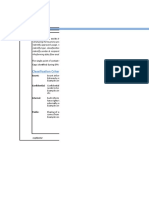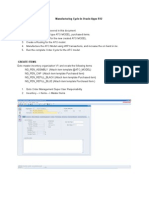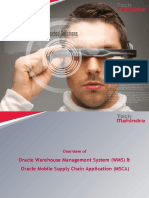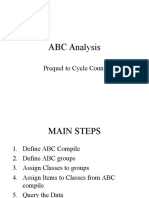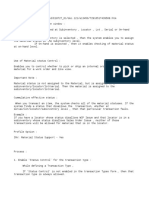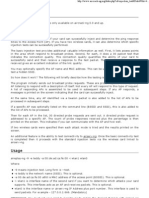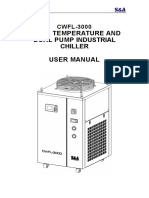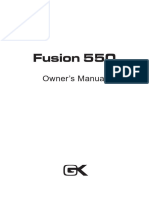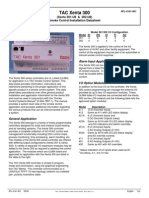O2c Cycle
O2c Cycle
Uploaded by
Madhuri NaiduCopyright:
Available Formats
O2c Cycle
O2c Cycle
Uploaded by
Madhuri NaiduOriginal Description:
Original Title
Copyright
Available Formats
Share this document
Did you find this document useful?
Is this content inappropriate?
Copyright:
Available Formats
O2c Cycle
O2c Cycle
Uploaded by
Madhuri NaiduCopyright:
Available Formats
ORDER TO CASH CYCLE
Order to cash cycle is the business process which is concerned with the process of selling of goods to the customer and receiving the corresponding payment for the sold goods. Order to Cash Cycle have the below mentioned steps 1.Enter Order 2.Book Order 3.Pick Release the Order 4.Ship Confirm 5.Invoice Creation 6.Payment Receipt
Pre-requisites for raising Sales order(SO):
->Customers who raise Purchase Order (PO) are the one that are defined in TCA. ->Items required must be in the item masters of inventory. ->Price of item are been defined in the price List maintained in Advanced Pricing. ->Warehouses must be defined where we stock the items. ->Shipping methods must be defined in inventory module. ->Sales person information is maintained at Accounts Receivables (AR) and Order Management(OM).
1)
ENTER SALES ORDER:
Navigation: Order Management Super User Orders, Returns Sales Orders This is the first stage of the Order to Cash cycle. Order entry is concerned with the process of entering the order related information in the system, no processing is done on the entered information the data is only saved in Oracle. Order entry is performed only when a purchase requisition is received from the customer. When the order information is entered and saved the data is entered in the OE_ORDER_HEADERS_ALL and OE_ORDER_LINES_ALL table.When the order information is entered and saved, an order number is generated by Oracle.
Tables Affected on ORDER ENTRY: 1. OE_ORDER_HEADERS_ALL :Containing order header information 2. OE_ORDER_LINES_ALL: Containing order line information 3. OE_PRICE_ADJUSTMENTS: Stores information of any discounts or charges applied to the order
Quries:
SELECT HEADER_ID, FLOW_STATUS_CODE, BOOKED_FLAG FROM OE_ORDER_HEADERS_ALL WHERE ORDER_NUMBER=69298; (Header_id=204688,Flow_status_code=Entered, booked_flag=N) SELECT FLOW_STATUS_CODE, BOOKED_FLAG FROM OE_ORDER_LINES_ALL WHERE HEADER_ID=204688; (Flow_status_code=Entered, booked_flag=N)
2)
BOOK ORDER:
Order booking is the process of validating the information entered by the user and if the data is valid book the order for further processing.
When we try to book the order, checks are performed to check if the order is eligible for booking or not. Credit check validation is performed against the customer for whom the order is booked to check if the credit limit for the customer exceeds on booking the order, If so then the order is put on hold with the entries being made in oe_order_holds table, the entry can be tracked using the header_id of the order. Oracle checks if a Customer item cross reference exists for the item being booked for the customer. If not the Order will be booked and will be put on hold. If the Customer is enabled only for EDI (Electronic Data Interchange) order creation then the order is put on hold, since manual booking is not permissible for this customer. Oracle checks if the requested item is active, eligible for Sale. In case the order is put on hold the user needs to check which hold has been applied on the order and then take corrective actions and release the holds. To check the holds applied at Order Header level Go to Order Header and click on the Actions Button, select Additional Order Information. Line level holds can be checked by navigating to order lines --> Actions --> Additional Line Information ,holds tab of the form In case the user is eligible to release the holds the user can release the header/line level holds by navigating to Order Header/Line --> Actions --> Release holds.
Queries:
SELECT HEADER_ID, FLOW_STATUS_CODE, BOOKED_FLAG FROM OE_ORDER_HEADERS_ALL WHERE ORDER_NUMBER=69298; (Flow_Status_code=Booked, Booked_Flag=Y) SELECT FLOW_STATUS_CODE FROM OE_ORDER_LINES_ALL WHERE HEADER_ID=204688;
(Flow_Status_code=Awaiting_shipping)
SELECT Wd.RELEASED_STATUS, Wd.DELIVERY_DETAIL_ID FROM OE_ORDER_HEADERS_ALL OOH,WSH_DELIVERY_DETAILS Wd WHERE WD.SOURCE_HEADER_ID=OOH.HEADER_ID AND OOH.HEADER_ID= 204688; (Released_Status='R'(Ready to Release), Delivery_detail_id= 4146535 ) SELECT DELIVERY_ID FROM WSH_DELIVERY_ASSGINMENTS WHERE DELIVERY_DETAIL_ID=4146535 ; (delivery_id is BLANK , a Record is created at this stage)
ORDER SCHEDULING
Order Scheduling is mechanism in which the system is informed about a possible demand of the item and the reservations that need to be done for the same. A new row is inserted in mtl_demand table with column demand_source_line = Order line_id Order Reservation : refers to the activity in which the items are blocked in the inventory for this particular order . The items are reserved to fulfill the requirements for this order and is thus not available for the fulfilment of other order requirements.
Tables Affected:
1) 2) mtl_demand mtl_reservations
3)
PICK-RELEASE:
Navigation: Order Management Super User Shipping Release Sales Order Release Sales Order. Pick release is the stage of the order cycle when the ordered items are transferred to the staging area of the sub-inventory to be shipped. The flow is as follows: 1) 2) When an order is booked based on the set ups the lines are scheduled and they are ready to release. This means that the inventory is informed that there is a requirement of certain quantity of certain items on certain date On the day if delivery or sometime between the items are taken out of the inventory and moved to staging sub-inventory. This means that the items are now ready for shipping and are out of inventory.
When the items reach staging sub inventory they are said to be picked and shipping execution can now ship these items.
If AUTO ALLOCATE and AUTO PICK CONFIRM are set to NO then pick release does nothing except creating the move order. If AUTO ALLOCATE is set to YES in release rule with the warehouse and sub inventory name then pick process also does an allocation/detailing of the item in the pick from sub inventory. If PICK CONFIRM is set to YES then the pick release process also does the transact move order and end of pick release process materials move automatically to the staging sub inventory. In case the delivery line status changes from 'ready to release' to 'staged/pick confirmed' but if either of the auto allocate/auto pick confirm is set to NO then status changes to released to warehouse and the user needs to transact the move order manually. If there is no Onhand then the order is backordered and no move order is created If there is no sufficient onhand then move order is created for the available onhand.
PICK SLIP REPORT: Pick slip contains a picked lines move order delivery and trip numbers. This is used by warehouse personals only. 1)Release Rules:-Release rules define the criteria to be used during pick release.Only order which meet the criteria and are eligible will be released. 2)Release Sequence rules:-The order in which sales orders are filled could be very important.If the company has a problem of running out of material before all their orders have been filled,it is very important that they filled their most important orders first. Release sequence rules are based on attributes like 1) Order number 2) Outstanding invoice value 3) Schedule date 4) Departure date 5) Shipment priority Tables Affected: OE_ORDER_LINES_ALL:order line status is updated WSH_DELIVERY_DETAILS :released status chages to 'Y' if pick release is successful, to 'B' in case the line is backordered WSH_NEW_DELIVERIES:details of the delivery created for the lines pick released WSH_DELIVERY_ASSIGNMENTS:association of delivery with order lines MTL_ONHAND_QUANTITIES:entries made for the increase of onhand in STAGE and updates for the goods moving out of the source sub-inventory MTL_MATERIAL_TRANSACTIONS:entries tracking the movement of goods in the warehouse
Queries:
Pick Release: SELECT STATUS_CODE FROM WSH_NEW_DELIVERIES WHERE delivery_id=39104;
(Status_code='OP')
SELECT Wd.RELEASED_STATUS, Wa.DELIVERY_ID FROM WSH_DELIVERY_DETAILS Wd , wsh_delivery_assignments Wa WHERE Wd.delivery_detail_id=Wa.DELIVERY_DETAIL_ID AND Wa.DELIVERY_ID=3910414 ; (Released_Status='S'(Released to Warehouse),Delivery_id= 39104); Pick Confirm: SELECT FLOW_STATUS_CODE FROM OE_ORDER_LINES_ALL WHERE HEADER_ID=204688 ;(Flow_status_code='Staged/Picked') SELECT Wd.RELEASED_STATUS FROM OE_ORDER_LINES_ALL OOL,WSH_DELIVERY_DETAILS Wd WHERE WD.SOURCE_HEADER_ID=OOL.HEADER_ID AND OOL.HEADER_ID= 204688; (Released_Status='Y'(Released) )
4)
SHIP CONFIRM:
Navigation: OM super User Shipping Transactions. After the Order has been picked next comes the stage of shipping of the Order. Ship confirmation is the step in which the goods are shipped to the customer site. This is the step where the inventory leaves the suppliers warehouse to be sent to the customer. The user needs to search the orders to be shipped and then perform the shipping transaction. When the shipping is done some supporting documents like Bill of Lading is generated. These documents help in the identification of the goods to be shipped in the staging area and are used by the truckers when performing the actual delivery of goods.
1) INTERFACE TRIP STOP:- this process executes either as real time or as a concurrent request. Typically this process accomplishes 3 steps. ->Deducts on-hand quantity and debits cost of goods sold. ->Progresses the order line to 'shipped' status so that it can progress to the next workflow activity. ->Progresses the shipment line to an 'interfaced' status and sets the trip to 'in-transit' or closed' depending whether we elected to close trip. 2)PACKING SLIP REPORT:-It prints all the shipment information usually packing slip is used by packers to verify the content before it leaves the warehouse, it is used by the carrier as an evidence for the goods he is carrying. Customer receiving team also uses this packing slip to verify all the contents they received as printed in packing slip. This document contains 1) Customer name 2) Ship to, Bill to Address 3) Ship date 4) Freight and payment terms 5) Order date 6) Sales person
7) Freight type 8) Freight amount 9) Unit of measure 10) Quantity ordered 11) Purchase order number ,etc. 3)BILL OF LADING:- It is a legal document which also serves as a receipt of shipment when the good is delivered to the pre-determined destination. This document must accompany the shipped goods no matter the form of transportation. This must be signed by an authorized representative from the carrier shipper and receiver. 4)COMMERCIAL INVOICE:-This is a standard oracle report that prints the commercial invoice at the time of ship confirm. This report prints 1) Delivery/ship information covering customer. 2) Sales order 3) Items 4) Quantity 5) Weight 6) Volume etc. This is different from 'AR' invoice. Commercial invoice is for legal/shipment purpose and travels along with goods whereas AR invoice is used for invoicing/payment from customer. Tables affected: WSH_DELIVERY_DETAILS: Released_status changes to ship confirmed OE_ORDER_LINES_ALL:Flow_Stauts_code changes to Shipped. MTL_MATERIAL_TRANSACTIONS: An Entry is made signifying the shipping of goods from the sytsem.If the transaction quantity is negative means goods are moving out of the system. MTL_ONHAND_QUANTITIES : The Corresponding entry is deleted, Since the goods have been shipped.
Queries:
SELECT STATUS_CODE FROM WSH_NEW_DELIVERIES WHERE delivery_id=39104; (Status_code= blank,data is removed from this table) SELECT FLOW_STATUS_CODE FROM OE_ORDER_LINES_ALL WHERE HEADER_ID=204688 ;(Flow_Staus_code='Shipped') SELECT Wd.RELEASED_STATUS FROM OE_ORDER_LINES_ALL OOL,WSH_DELIVERY_DETAILS Wd WHERE WD.SOURCE_HEADER_ID=OOL.HEADER_ID AND OOL.HEADER_ID= 204688; (Released_Status='C'(Shipped) )
5)
CREATING AN INVOICE:-
After the Order has been picked next comes the stage of invoicing where invoice are created for the sold goods.
Navigation: Receivables Super User Transactions Transactions
We run a workflow background process which picks up all the shipped order lines,changes their status to 'closed' and inserts corresponding records in RA_INTERFACE_LINES_ALL. The Invoice created can be seen using the Receivables responsibility Inserted records are Interface_line_context=order entry (order no) Interface_line_attribute1=order_number Interface_line_attribute3=Delivery_id/shipment id. Interface_line_attribute6=line_number. It spawns Auto invoice Master Program and Auto invoice import program which creates Invoice for that particular Order. Tables Affected: RA_CUSTOMER_TRX_ALL : TRX_NUMBER is the invoice number. RA_CUSTOMER_TRX_LINES_ALL: where the LINE_ATTRIBUTE_1 is the ORDER NUMBER and LINE_ATTRIBUTE_6 is the ORDER LINE ID
Queries:
select trx_number from ra_customer_trx_all where INTERFACE_HEADER_ATTRIBUTE1='69298';
6)
RECEIPTS:When payment is received from a customer the corresponding needs to be entered in Oracle.This is done from the Receipts screen. Navigation: AR Super User Receipts Receipts Here the user needs to enter the amount received from the customer and apply it to the corresponding invoices to which he desires. The receipt amount can either be applied to a single invoice or multiple invoices.
Tables affected: AR_CASH_RECEIPTS_ALL: Gives the receipt number. AR_RECEIVABLE_APPLICATIONS_ALL: Gives the Cash Receipt id.
Query:
SELECT rc.TRX_NUMBER as INVOICE_NUMBER,ac.RECEIPT_NUMBER FROM RA_CUSTOMER_TRX_ALL rc, AR_RECEIVABLE_APPLICATIONS_ALL ar , AR_CASH_RECEIPTS_ALL ac,OE_ORDER_HEADERS_ALL oe where TO_CHAR(oe.ORDER_NUMBER)=rc.INTERFACE_HEADER_ATTRIBUTE1 AND rc.CUSTOMER_TRX_ID=ar.APPLIED_CUSTOMER_TRX_ID AND ar.CASH_RECEIPT_ID=ac.CASH_RECEIPT_ID AND oe.ORDER_NUMBER=69298;
You might also like
- DFA TemplateDocument28 pagesDFA TemplateVedant KashyapNo ratings yet
- Advance Return ManagementDocument14 pagesAdvance Return ManagementParinit Agarwal100% (3)
- 1 - Practice Assignment (ER - Diagram)Document3 pages1 - Practice Assignment (ER - Diagram)Saniya SaniNo ratings yet
- OPICDocument32 pagesOPICTasha100% (1)
- SWM0101 G500 Software Configuration Guide V100 R0 PDFDocument625 pagesSWM0101 G500 Software Configuration Guide V100 R0 PDFIlaiyaa RajaNo ratings yet
- CAL To-Be Order Management and Shipping Execution v.02 12-Dec-2013Document20 pagesCAL To-Be Order Management and Shipping Execution v.02 12-Dec-2013Tharmaraj MuralikrishnanNo ratings yet
- Manufacturing Cycle in Oracle Apps R12Document15 pagesManufacturing Cycle in Oracle Apps R12saqi22No ratings yet
- HCC EBS AMS Project - Common Issues: Period - Feb-Mar 2019Document5 pagesHCC EBS AMS Project - Common Issues: Period - Feb-Mar 2019AbhijitNo ratings yet
- Agenda: - Understanding Order ImportDocument4 pagesAgenda: - Understanding Order ImportNidhi SaxenaNo ratings yet
- Using Procure To Order' To Source Buy Items Cross OrganizationsDocument46 pagesUsing Procure To Order' To Source Buy Items Cross OrganizationsNidhi SaxenaNo ratings yet
- R12 PresentationDocument66 pagesR12 PresentationBhuiyan Rahman Anisur100% (1)
- Inventory Control - Best Practices and Everything You Need - NetSuiteDocument41 pagesInventory Control - Best Practices and Everything You Need - NetSuiteinformsueNo ratings yet
- FIN - Fixed Assets - Core Team Training - CDocument92 pagesFIN - Fixed Assets - Core Team Training - CbarbarabolognesiNo ratings yet
- Multi Organization Architecture in Oracle Applications R12Document8 pagesMulti Organization Architecture in Oracle Applications R12Venu AdaguriNo ratings yet
- ExtraMiles - Reconciliation Oracle Fusion v1.1Document25 pagesExtraMiles - Reconciliation Oracle Fusion v1.1figmakhalilNo ratings yet
- Dhanush Infotech: Submitted ToDocument30 pagesDhanush Infotech: Submitted ToS.GIRIDHARAN100% (1)
- Inventory Receiving Processes For Serial Controlled ItemsDocument28 pagesInventory Receiving Processes For Serial Controlled ItemsSaurabh SonkusareNo ratings yet
- OPM Migration ChecklistDocument20 pagesOPM Migration Checklistkarthik2190No ratings yet
- Oracle SCM Functional Guide - Oracle SCM Functional Interview Questions & Answers - Order Management Module - Part I PDFDocument3 pagesOracle SCM Functional Guide - Oracle SCM Functional Interview Questions & Answers - Order Management Module - Part I PDFAravind AllamNo ratings yet
- Depot Repair TypeDocument3 pagesDepot Repair TypeShahjahan MohammedNo ratings yet
- Team ProjectsDocument76 pagesTeam ProjectsSachin A PillaiNo ratings yet
- Order Management and Fulfillment Implementation R13 - Activity GuideDocument151 pagesOrder Management and Fulfillment Implementation R13 - Activity Guidenarenc514No ratings yet
- Oracle® Procurement Command Center: Process Guide Release 12.2Document116 pagesOracle® Procurement Command Center: Process Guide Release 12.2yadavdevender100% (1)
- Modern Best Practices Internet of Things (Iot) and Adaptive Intelligence (Ai)Document8 pagesModern Best Practices Internet of Things (Iot) and Adaptive Intelligence (Ai)sanjeev19_ynrNo ratings yet
- Application: Account Receivables Title: Receipt Remittance: OracleDocument31 pagesApplication: Account Receivables Title: Receipt Remittance: OraclesureshNo ratings yet
- Best in Class Practices - Quote To CashDocument29 pagesBest in Class Practices - Quote To CashAmaldev VasudevanNo ratings yet
- Dairy Industry - AMULDocument102 pagesDairy Industry - AMULnishutha3340No ratings yet
- Oraclewmsandoraclemscaoverview 170202051623Document62 pagesOraclewmsandoraclemscaoverview 170202051623manitenkasiNo ratings yet
- Data Migration: Posted by VelurugaDocument3 pagesData Migration: Posted by VelurugarajNo ratings yet
- SFO Global ProcurementDocument14 pagesSFO Global Procurementniranjan krishnaNo ratings yet
- Area Expected Answer Comments: Consultant Name Consultant Tel: Agency & ContactDocument3 pagesArea Expected Answer Comments: Consultant Name Consultant Tel: Agency & ContactPrasad KaruturiNo ratings yet
- Oracle Isupplier Sit SessionsDocument13 pagesOracle Isupplier Sit SessionsNaveen Shankar MauwalaNo ratings yet
- ABC Analysis Training PresentationDocument14 pagesABC Analysis Training PresentationmrsarojnayakNo ratings yet
- Autoinvoice Setup For R12Document34 pagesAutoinvoice Setup For R12reco83No ratings yet
- Periodic Costing Troubleshooting - Oracle r12Document6 pagesPeriodic Costing Troubleshooting - Oracle r12Fernanda Gerevini PereiraNo ratings yet
- Real Time S & OP With APCC: Chandra Pandey - Director Supply ChainDocument43 pagesReal Time S & OP With APCC: Chandra Pandey - Director Supply ChainSanjeev ThakurNo ratings yet
- Fusion Work Order CostingDocument14 pagesFusion Work Order CostingVenkata Ramanaiah KokaNo ratings yet
- Oracle Fleet Management PDFDocument3 pagesOracle Fleet Management PDFRiyaz RasperNo ratings yet
- BP.080 F P M: Fixed AssetsDocument26 pagesBP.080 F P M: Fixed AssetsKrishaNo ratings yet
- Collections Manager (R12.1sv1)Document17 pagesCollections Manager (R12.1sv1)Mahmoud RagabNo ratings yet
- The IT Convergence Oracle R12 Upgrade v11 PDFDocument8 pagesThe IT Convergence Oracle R12 Upgrade v11 PDFsoireeNo ratings yet
- I Supplier Portal-Supplier User GuideDocument26 pagesI Supplier Portal-Supplier User GuidefotvNo ratings yet
- AR General Setup-StepsDocument18 pagesAR General Setup-StepsJayakumar ManoharanNo ratings yet
- Best Practices For Oracle ReceivablesDocument31 pagesBest Practices For Oracle ReceivablesHussein SadekNo ratings yet
- Process Vs Discrete ManufacturingDocument7 pagesProcess Vs Discrete Manufacturingtahir_mydataNo ratings yet
- Oracle R12 Supplier Life Cycle Management Is A Component of Oracle EDocument2 pagesOracle R12 Supplier Life Cycle Management Is A Component of Oracle EnahlaNo ratings yet
- Exam 1z0-963: IT Certification Guaranteed, The Easy Way!Document23 pagesExam 1z0-963: IT Certification Guaranteed, The Easy Way!Praveen KumarNo ratings yet
- Oracle Landed Cost Management - 2 PDFDocument3 pagesOracle Landed Cost Management - 2 PDFMohamed MahmoudNo ratings yet
- Complex Services Work ConfirmationDocument66 pagesComplex Services Work ConfirmationShashank Padhye100% (2)
- JVC AP BR100 v0.1Document71 pagesJVC AP BR100 v0.1Gopalakrishna DevulapalliNo ratings yet
- Service Contract - Install BaseDocument10 pagesService Contract - Install Baseshivamba_chinnu_3332100% (1)
- Material Status in InventoryDocument2 pagesMaterial Status in InventoryJaya KrishnaNo ratings yet
- R12 ProcurementDocument73 pagesR12 ProcurementSaif AhmedNo ratings yet
- Best in Class Practices - Record To ReportDocument22 pagesBest in Class Practices - Record To ReportAmaldev VasudevanNo ratings yet
- Getting Errors When Submitting DOR Error Caused by SOA Component or The Underlying HWF Configuration or A Supervisor Hierarchy Setup IssueDocument3 pagesGetting Errors When Submitting DOR Error Caused by SOA Component or The Underlying HWF Configuration or A Supervisor Hierarchy Setup Issuehamdy20017121No ratings yet
- Oracle Inventory Management R12 Features and Highlights: Your Friend in The BusinessDocument28 pagesOracle Inventory Management R12 Features and Highlights: Your Friend in The BusinessVikram ReddyNo ratings yet
- Financial Dashboards and Standard Reports PDFDocument55 pagesFinancial Dashboards and Standard Reports PDFVijaya GaliNo ratings yet
- Oracle Fusion Applications A Complete Guide - 2019 EditionFrom EverandOracle Fusion Applications A Complete Guide - 2019 EditionNo ratings yet
- Oracle SOA BPEL Process Manager 11gR1 A Hands-on TutorialFrom EverandOracle SOA BPEL Process Manager 11gR1 A Hands-on TutorialRating: 5 out of 5 stars5/5 (1)
- Warehouse Management Systems A Complete Guide - 2021 EditionFrom EverandWarehouse Management Systems A Complete Guide - 2021 EditionNo ratings yet
- GC 2024 11 05Document9 pagesGC 2024 11 05John Rheynor MayoNo ratings yet
- 98-381.exam.20q: Number: 98-381 Passing Score: 800 Time Limit: 120 Min File Version: 1Document35 pages98-381.exam.20q: Number: 98-381 Passing Score: 800 Time Limit: 120 Min File Version: 1Cahaya DakwahNo ratings yet
- Data FlexibelDocument70 pagesData Flexibeldna laptop MalangNo ratings yet
- BTC - Autopilot - Method - MAKE - 700$-800$ - PER - WEEKDocument4 pagesBTC - Autopilot - Method - MAKE - 700$-800$ - PER - WEEKUrban ChhoraNo ratings yet
- Injection Test NG AircrackDocument5 pagesInjection Test NG Aircrackzombira32No ratings yet
- DxDiag of A Typical SystemDocument38 pagesDxDiag of A Typical SystemrzNo ratings yet
- Resume Mackenzie Bartz 1Document1 pageResume Mackenzie Bartz 1api-484383905No ratings yet
- Instruktsiya Dlya Eksplua II Chillera CWFL 3000Document34 pagesInstruktsiya Dlya Eksplua II Chillera CWFL 3000Upul ChandanaNo ratings yet
- Hieronimo Mengo - Praxis Exorcistarum Sive Fustis DaemonumDocument461 pagesHieronimo Mengo - Praxis Exorcistarum Sive Fustis DaemonumIan ThomsonNo ratings yet
- HT67F488 HoltekSemiconductorDocument160 pagesHT67F488 HoltekSemiconductorElpanita3No ratings yet
- Gallien Krueger Fusion 550 Manuel Utilisateur en 29055Document12 pagesGallien Krueger Fusion 550 Manuel Utilisateur en 29055Jose RocaNo ratings yet
- Solutions Assignment No. 2Document4 pagesSolutions Assignment No. 2Gurinder Pal SinghNo ratings yet
- Planeamiento de Mina 3Document32 pagesPlaneamiento de Mina 3Edgar LuchoNo ratings yet
- Wa815 / Za815 Websphere Application Server V8.5.5 Performance TuningDocument11 pagesWa815 / Za815 Websphere Application Server V8.5.5 Performance TuningBi BôngNo ratings yet
- Mobile Learning Handheld Classroom PDFDocument7 pagesMobile Learning Handheld Classroom PDFJuan BendeckNo ratings yet
- ConferenceBrochure 2012 PDFDocument2 pagesConferenceBrochure 2012 PDFbarveysNo ratings yet
- Android Based Advanced Attendance Vigilance System Using Wireless Network With Fusion of Bio Metric Fingerprint AuthenticationDocument40 pagesAndroid Based Advanced Attendance Vigilance System Using Wireless Network With Fusion of Bio Metric Fingerprint AuthenticationAPOORVA RNo ratings yet
- ES400 Manual v220915Document122 pagesES400 Manual v220915Pablo Isaias IrahetaNo ratings yet
- Tac Xenta 300 Smoke Control Installation Instructions l4141001Document4 pagesTac Xenta 300 Smoke Control Installation Instructions l4141001SupolNo ratings yet
- Siemens Power Engineering Guide 7E 432Document1 pageSiemens Power Engineering Guide 7E 432mydearteacherNo ratings yet
- Linear Approximations and GPS Project: Catholic Social TeachingDocument10 pagesLinear Approximations and GPS Project: Catholic Social Teachingapi-457258209No ratings yet
- Analysis and Algorithms For Service Parts Supply ChainsDocument290 pagesAnalysis and Algorithms For Service Parts Supply ChainsbudiaeroNo ratings yet
- Hh-411 Impact Type Hardness Testing Unit: Catalog No. E4299-810Document6 pagesHh-411 Impact Type Hardness Testing Unit: Catalog No. E4299-810D.T.No ratings yet
- Good Testing Practice: Part 2: David StokesDocument16 pagesGood Testing Practice: Part 2: David StokesdesignselvaNo ratings yet
- Mandatory Standards 30thoctDocument71 pagesMandatory Standards 30thoctfisplNo ratings yet
